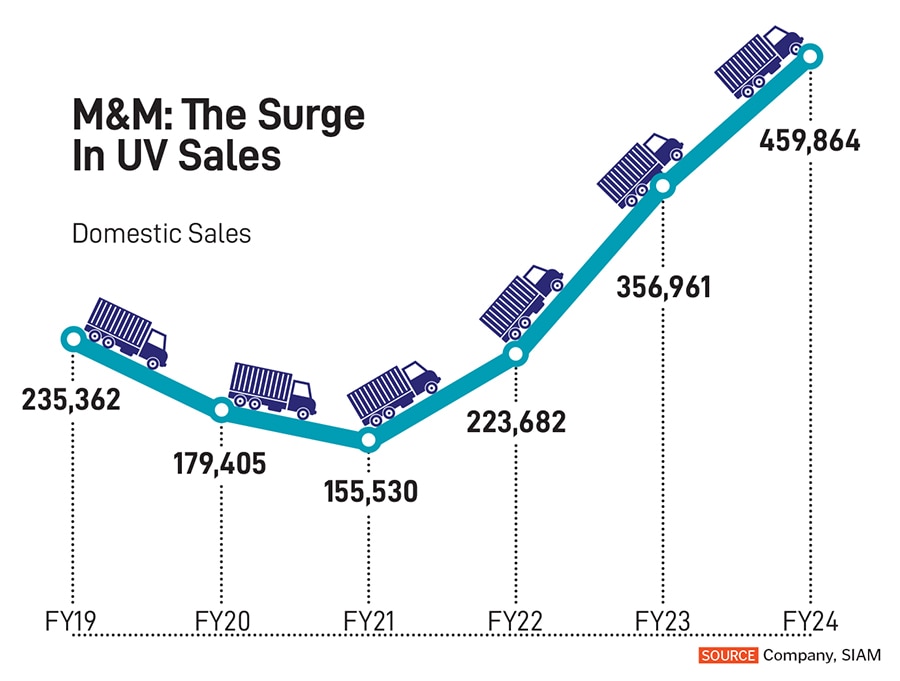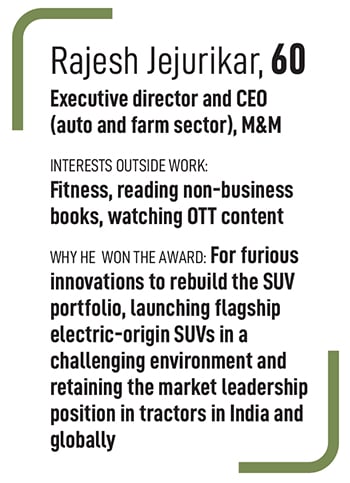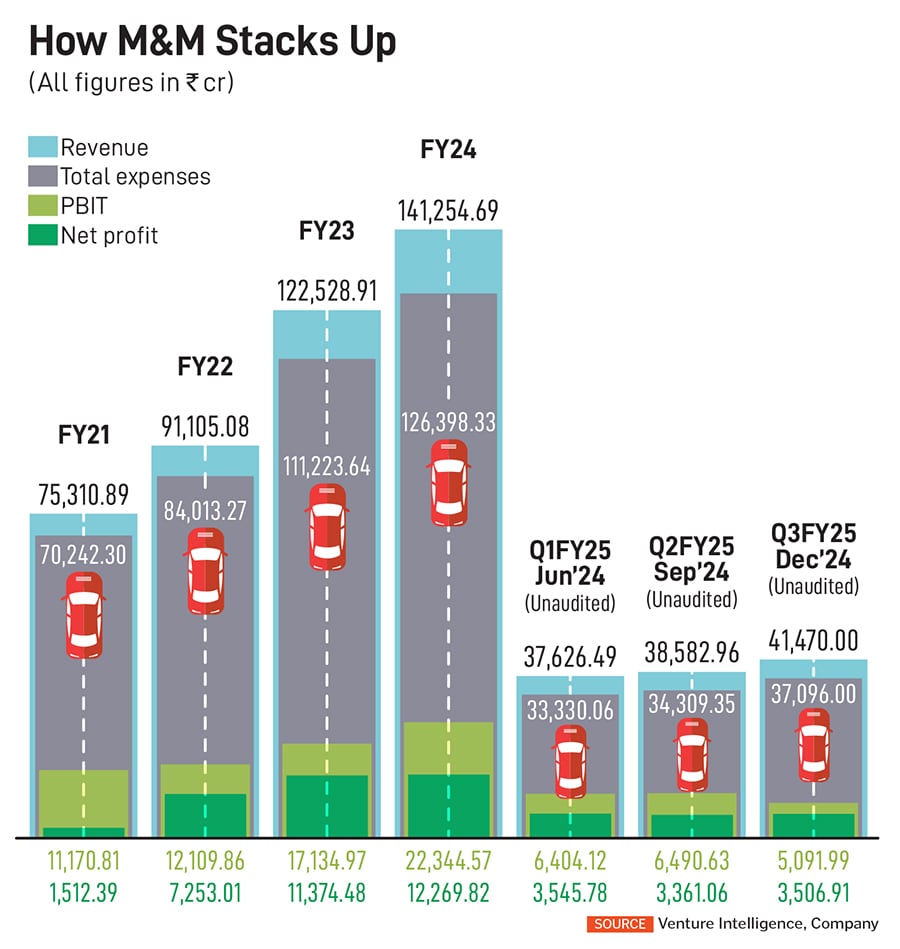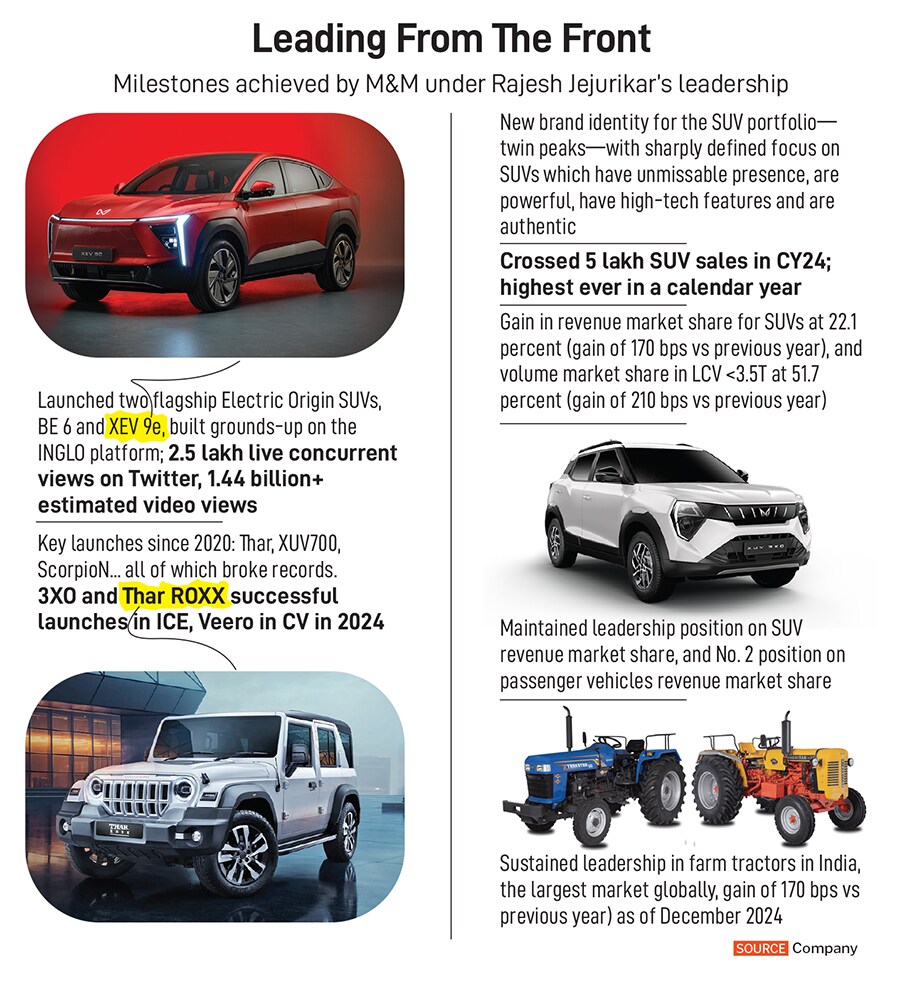Coming late into the EV space, the first task for Rajesh Jejurikar, Mahindra & Mahindra’s (M&M) executive director and CEO (auto and farm sector), and his team was to have a ‘wow’ design. Based on the INGLO electric-origin architecture, the BE 6 is unlike any other vehicle on the road—from its name on the bonnet to an air duct for better aerodynamics. Stepping into it gives the sense of the BE 6 being a ‘driver’s vehicle’ with a race-car-type feel with the steering wheel and an airplane-type selection of driving functions.
The BE 6 and XEV 9e SUVs don’t carry the company logo. The two latest EVs—whose bookings opened on Valentine’s Day—are being launched in challenging times, but are technology-rich products from Mahindra Auto. The launches also come at a time when some electric models in India are cheaper than petrol cars.
Mahindra said on February 14 that both the EVs got booking orders of 30,179 on the first day, which translates to a booking value of ₹8,472 crore (ex-showroom price). The BE 6 got 44 percent of the orders while the remaining were for the XEV. The opening booking orders are strong considering the annual industry EV sales.
While the number of EVs has been growing, their pace of growth has fallen. In 2023, 83,000 four-wheeler EVs were sold (151 percent year-on-year jump), but the number grew by just 19 percent to 99,000 in 2024, according to Vahan Parivahan data (a nationwide vehicles registration website of the Ministry of Road Transport). Building the charging ecosystem in India is still a challenge, and, as of FY25, EV penetration in the country was a low 3 percent. Have M&M, and Jejurikar, got their EV strategy and timing right?
![]()
The Risk-Taker
Jejurikar, a Mahindra group veteran of over 22 years, is not averse to taking risks and making tough business decisions. The 60-year-old took charge as executive director and CEO of the auto and farm equipment sector on April 1, 2020—seven days after Covid-19 resulted in a nationwide lockdown. And global automakers were hit by restrictions in production and weakening demand for vehicles.
![]() For SUVs, Mahindra Auto formalised a strategy called ‘Brand Purpose’, which was about creating authentic SUVs that are adventure-ready and sustainable, but with sophistication and technology. Pre-Covid-19, SUVs were estimated to be just a third of the market (see Mahindra UV sales growth), and medium-to-small cars were selling better.
For SUVs, Mahindra Auto formalised a strategy called ‘Brand Purpose’, which was about creating authentic SUVs that are adventure-ready and sustainable, but with sophistication and technology. Pre-Covid-19, SUVs were estimated to be just a third of the market (see Mahindra UV sales growth), and medium-to-small cars were selling better.
However, after the pandemic, premiumisation set in and customers became more aspirational. They were willing to shell out more for products perceived to be better. SUVs now command a 60 percent share of the domestic passenger vehicle market.
Three vehicles—the three-door Thar, the XUV700 and Scorpio N—that were designed before the pandemic have since become some of Mahindra Auto’s best-selling vehicles. EVs were gaining popularity, but selling in small numbers. Jejurikar flipped the strategy around for EVs to ‘infinite possibilities’. They were made accessible and aspirational.
“The reason to buy our cars was ruggedness, ability to repair anywhere and that they were fuel-efficient. But with EVs, we are moving away from that to a different category of vehicles that are going to be high on image, aspirational, accessible, but not fleet," Jejurikar tells Forbes India at the company’s corporate headquarters in Mumbai.
Traditionally, automakers in India have preferred focusing on fleet sales—being a large revenue generator—by selling large number of vehicles to businesses, government agencies and rental car companies. Jejurikar is taking a risk with EVs in this strategy by combining affordability, aspiration and best-in-technology.
Kapil Singh, executive director at Nomura India, who tracks the automobile sector, says M&M has taken several risks in recent years and come out strong. “A revamped Thar was a bit of a risk… it had a good image and was a well-known brand, but an unknown category. Each product that came after that was a significant improvement. The M&M team ensured the customer felt ‘wow’, whether it be the XUV700, Scorpio N, 3XO… all were products best in class."
In each case, there was a challenge—either creating a new category or being in segments which were small. M&M has offered products which are priced one or two segments above technology which can attract those price points, says Singh.
![]()
EV and SUV strategy
It’s not just the specifications that are creating a buzz around the new EV launches. The BE 6—that aims to take on rivals such as the Tata Curvv EV, Hyundai Creta EV and Maruti e-Vitara—offers attractive pricing, starting at ₹18.9 lakh for a Pack One version, with a 59 kwh battery pack. The price goes up to ₹26.9 lakh for a Pack Three version, offering both 59 kwh and 79 kwh battery packs.
The range for the BE 6 is in excess of 500 kilometres on a single charge. Charging from 20 percent to 80 percent takes just 20 minutes, using a 175 kw DC charger. This could mean that those who largely drive in the city need to charge the vehicle only two to three times a month. M&M also offers a lifetime battery warranty, which Jejurikar claims “removes one barrier towards EV adoption out of the way".
Besides, both the BE 6 and the XEV 9e come with coast-to-coast touch screen displays, auto park feature, a Level 2 ADAS (advanced driver assistance system), 16-speaker Harman Kardon system, augmented reality heads-up display on the windscreen and a great suspension system. Some of these features are available in higher-priced luxury cars.
![]()
Tata Motors, Mahindra’s closest rival, had launched its first EV in 2019, but it has always attempted to make them more affordable. Nuvama Wealth’s analyst Raghunandhan NL says, “Tata Motors offers EVs across the ex-showroom price spectrum—from the Tiago (₹8-11 lakh) to the Curvv EV (₹17-22 lakh). More EVs will emerge in the form of the Harrier, Sierra and the Avinya." Mahindra, on the other hand, offers the XUV400 EV (₹17-18 lakh), the BE 6 (₹19-27 lakh) and the XEV 9e (₹22 lakh-31 lakh), so it is a mid-to-premium-end EV manufacturer.
Nomura’s Singh says Tata Motors has been trying to democratise the EV market and make it more mainstream for all consumers. It will move towards the premium EV segment and M&M is already focussed on that.
M&M has said that between 20 and 30 percent of its SUV portfolio will be electric by 2027. However, this is a little tricky, assuming that the company will not abandon its ICE (internal combustion engine). “Whether that will be 20 to 30 percent of the ICE volume remains to be seen. We definitely don’t want to bring down the ICE volume, to achieve that goal," Jejurikar clarifies.
M&M is a clear winner at this stage in the SUV segment in terms of revenue market share, though Maruti Suzuki leads in volume terms. “Our view has always been that as long as you’re focussed on doing the right thing for the customer, you will lead," says Jejurikar. Maruti Suzuki has a volume share of 26 percent while Mahindra’s is around 20 percent for the April-December 2024 period, according to analysts.
Jejurikar recounts that when they revealed this strategy in 2020, many sceptics said the automaker was “going too niche". “But if you’re doing the right thing and we are able to get our proposition right to customers, market share and volume will follow," he adds. It was due to this mindset that M&M has stayed away from entering the micro SUV segment—dominated by Tata Motors’ Punch SUV and Maruti Suzuki’s Swift. “We don’t want to play in segments where we don’t have a right to win," Jejurikar emphasises.
Mahindra may well be on the right track. “Drivability, ride quality in existing road conditions make SUVs attractive buys. A few years ago, one concern would have been that certain portions of the market will possibly shift to petrol, and Mahindra has addressed that in both the 3XO and XUV700, where the petrol mix quotient is high. SUVs will continue to be the fastest-growing category among vehicles in India," says Singh.
After the Q3FY25 earnings on February 7, Jejurikar said: “We believe our products have hit a sweet spot with customers. In particular, the new launches in 2024—3XO and Thar ROXX—have received a tremendous response, enabling us to grow volumes in Q3FY25 at 20 percent, well above the industry growth rate of 4.5 percent."
Despite the domestic economic slowdown, M&M continues to show steady FY25 quarterly growth. “This is a segment which is the opposite of automobiles. Customers want as little change as possible," Jejurikar says. The main Swaraj brand is faring well, and M&M has a near-44 percent market share, gaining almost 3 percentage share points over the last year.
![]()
No Longer Bruised
At the public markets, M&M has pulled out of a challenging period, such as the one it saw between FY15 and FY20, prior to Jejurikar taking charge of the automobile and tractor business. Its market share fell to 19 percent in FY20 from 37 percent in FY15, despite retaining leadership position in tractors.
The SUV portfolio failed to gain traction at that time and even early moves into EV (through the e2o) had come when EV adoption in India was extremely slow. Suboptimal capital allocation (SsangYong acquisition), high operating costs and a focus on diesel powertrains impacted earnings and reflected in weak investor sentiment.
The dramatic turnaround between FY21 and FY24 due to a mix of leadership approach, focus on R&D and innovation, revitalisation of the portfolio—with new versions of the Scorpio, Thar and the XUV700—helped M&M regain market share. This was documented in Motilal Oswal’s December 2024 wealth creation report on Bruised Blue Chips (such as M&M), presented by market veteran Raamdeo Agrawal.
This resulted in sustained revenue growth (22 percent CAGR) in this period. It also boosted investor confidence, as the M&M stock rose 3x over FY21-24, to ₹2,939 on February 14, 2025, from ₹852 in February 2022, at the BSE. M&M had a market capitalisation of ₹3.38 lakh crore as of February 17.
![]()
Jejurikar puts the M&M corporate turnaround into perspective. “Investments made earlier to create its R&D and innovation centre, Mahindra Research Valley (MRV), in Chengalpattu, Tamil Nadu, and build the talent and capability of the team there took a few years to give us results. Today we have 4,000 engineers there on the auto division alone," he says. It also meant moving talent from internal teams to create the whole EV portfolio.
Mahindra’s electric-origin launches mean these are exciting times for the sector. “It will definitely be an important year for EVs and their demand," says Nuvama Wealth analyst Raghunandhan NL. Nomura’s Singh says the new products launched are “high-tech… consumers need to be made aware of these. These are also products launched in a very difficult market".
But M&M has heavyweights in Jejurikar’s team, including Veejay Nakra (president, automotive division), Vinod Sahay (part of the group executive board of the Mahindra group) and Suman Mishra (CEO, Mahindra Electric Mobility). They have ably dealt with several market challenges to gain leadership position. The EV journey of 2025 and continuing to build on SUV leadership will be part of that journey.


 For SUVs, Mahindra Auto formalised a strategy called ‘Brand Purpose’, which was about creating authentic SUVs that are adventure-ready and sustainable, but with sophistication and technology. Pre-Covid-19, SUVs were estimated to be just a third of the market (see Mahindra UV sales growth), and medium-to-small cars were selling better.
For SUVs, Mahindra Auto formalised a strategy called ‘Brand Purpose’, which was about creating authentic SUVs that are adventure-ready and sustainable, but with sophistication and technology. Pre-Covid-19, SUVs were estimated to be just a third of the market (see Mahindra UV sales growth), and medium-to-small cars were selling better.


